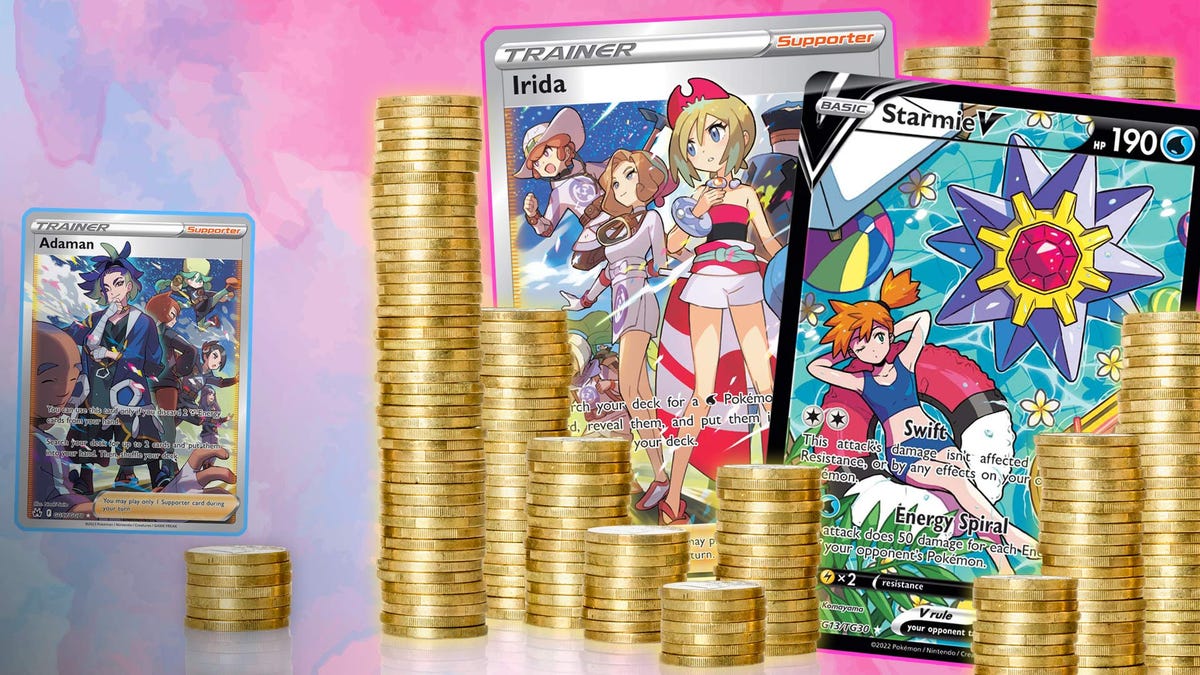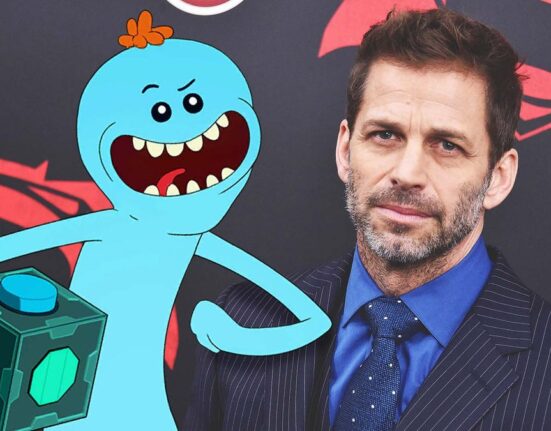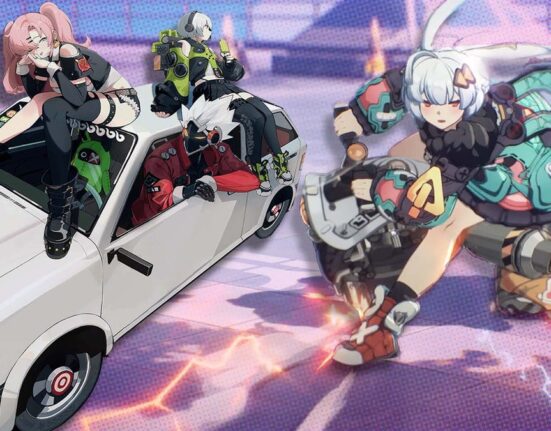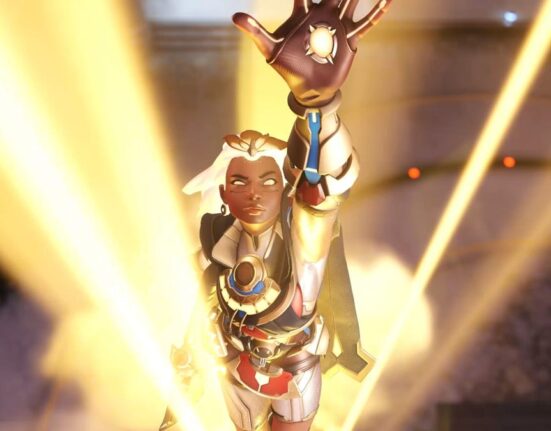On January 20, the latest expansion of the Pokémon Trading Card Game released in Japan in the form of twin sets Scarlet EX and Violet EX. They’re due for an English release in March, or you can pre-order the Japanese versions from importers right now. But there’s a catch.
One of the UK’s leading importers, Japan2UK, lists Scarlet EX booster boxes for pre-order at £89.99 (around $110), which is a fairly standard price for an imported booster box. Violet EX booster boxes, however, are listed at £129.99 (around $155). This discrepancy is apparent at multiple importers, so why the £40 increase?
“Violet has multiple cards in the set which are being chased hard by collectors and hence has driven price up,” a Japan2UK representative told Kotaku. “Due to this, demand [for] Violet boxes in Japan has been lifted to exponential levels therefore increasing price.”
What is it specifically that leads a handful of cards to drive up retail prices?
“Girls,” said tokyobull1, a collector from Europe who often travels to Japan. “In the Scarlet set, there is no waifu. With the Violet set, you have Miriam.”
This is the most recent example of a longstanding trend in the Pokémon TCG, in which the most valuable cards aren’t Pokémon, but women and young girls. Fans regularly refer to these cards as “waifu” cards.
The term “waifu” is fandom slang for an animated or illustrated character that one finds attractive. In Pokémon, the term is used to describe “any card depicting and focusing on a female character,” according to another European collector who asked not to be identified.
While “waifu” cards are nothing new in trading card games, they still represent an uncomfortable side of the hobby, and one that’s now exerting very real effects on the Pokémon Trading Card Game market.

Pokémon TCG’s “waifu tax”
Most collectors Kotaku spoke with agreed that no matter where these cards fit into their relative expansions, the source of their value is invariably down to including artwork of girls.
The anonymous European collector offered that while “rarity is a factor especially in Japan,” it represents “maybe 10 percent” of their value. And they categorically emphasized that the people pointedly chasing these cards are “after the ‘waifu.’”
Tokyobull1 added that while other cards may spike in value, “with the ‘waifus’ there is more of a constant” price rise. The community often refers to this as “waifu tax.”
Collectors frequently show off their “waifu” collections in online communities, making forum and community posts replete with children from the Pokémon universe including Misty, Lillie, and Marnie. Many are quick to admonish these posts and express discomfort, but others join in, remarking on how the cards are “cute” or “attractive.”
This phenomenon isn’t exclusive to the card game. In a 2008 interview with PokéBeach, the late former Pokémon anime director Hidaka Masamitsu talked about how the anime liked to switch out Ash’s female companions “because it gives boys some new eye candy every once in a while.” He went on to suggest, “Girls are more customizable and you can change their outfits, like when they’re in bathing suits.”
These attitudes persist and, entering the hobby in 2023, it’s clear there’s something of a horny problem in the Pokémon TCG. It’s a problem that multiple former fans told Kotaku has driven them from the hobby, and one that’s making enough waves to fundamentally change the market from retail to resale.

Ultra Rare and secret rare full art Pokémon cards
The exacerbation of this phenomenon can be traced to reforms in the structure of Pokémon cards. In the past, cards fit into simple categories: rare, uncommon, and common. But as the Pokémon TCG grew, that simple categorization scheme disappeared.
“Rare” cards are no longer especially rare. Rather, further categories like “ultra rare” and “secret rare”—as well as subcategories therein—have supplanted the holographic Wizards of the Coast cards we craved and traded around the millennium.
A major draw of modern Pokémon trading cards are the so-called ”full art” cards. These do away with the traditional layout of Pokémon cards and spread the artwork over the entire card’s surface. Coupled with higher-quality artwork, this makes full-art cards some of the most desirable, and most valuable, of modern Pokémon cards.
Sometimes these cards depict Pokémon, while others depict human characters.Within this specific microsystem is where we see the “waifu” discrepancy: major differences between the price of cards depicting male characters (sometimes referred to as “husbando” cards) and those depicting women and girls.
Some cards featuring actual Pokémon still pull big numbers. Fire-type OG Charizard retains value in the hobby after all these years, while crowd-pleasers like Lugia and Mew can still rack up hefty prices at resale. Even so, monster card prices often pale in comparison to the prices of cards showing women and girls.
Looking at Scarlet and Violet EX prices demonstrates how wide this chasm has become. The aforementioned Miriam secret art rare (SARs are a subset of “full art” cards) is currently listed from £486.67 (around $580) on Card Market, one of the most reliable sources for market prices of Japanese cards in the west. The other SAR character card from the Violet EX set, of male NPC Arven, has a current market price of just £49.03 (around $58). Miriam sees an almost 900 percent increase, despite Arven being a main character in the Scarlet and Violet games and a fan favorite besides.
“It’s not like Miriam is rare,” a U.S.-based collector who asked to remain anonymous told me. “She has an equal drop rate as other character cards.”
It’s just that her card depicts a female character.
We can track this phenomenon in older sets, too. Irida’s SAR in VSTAR Universe, the previous Japanese set, boasts a market price of £137.42 (around $165) while the male character Adaman, whose card has the same rarity rating and a similar composition, is listed at £21.87 (around $26). You can head further back to see similar discrepancies play out; for instance, 2017’s Alolan Midnight set only has one card that breaches the £40 barrier in Mallow, which has a market price of £472.50 (around $567). That’s more than the current market price for a Base Set Charizard.
While these pricing gulfs aren’t as dramatic in English-language sets (though the market remains volatile), the “waifu’’ discrepancy remains. Let’s look at the same VSTAR Universe cards’ English-language versions from the recent Crown Zenith expansion. Irida has a market price of $21.12—this time from TCGPlayer, a go-to reference for English card values—while Adaman’s market price is just $7.14. Going back to 2022’s Astral Radiance, one can pick up Hoothoot from the set’s trainer gallery (which depicts people alongside Pokémon) at a market price of $1.26, while Starmie V, prominently featuring Misty in a swimsuit, runs at $39.48.
One might suggest this discrepancy is down to art alone. For instance, Gym Heroes, the 7th TCG expansion, has no full-art cards, and utilizes the traditional layout. Erika is priced at $8.65 while Brock has a market price of $9.05. Both are rare, non-holo cards, yet both are priced similarly.
But this ostensible improvement in the presentation of cards from the Wizard of the Coast days does not entirely account for the enormous, gendered gap we see with modern, “full art” cards. The quality and scale of art certainly plays a part in price increases, but doesn’t explain the widening gulf between secondhand market prices of male and female cards.

Logan Paul and YouTube’s effect on Pokémon cards
All this talk of market value brings us to one of the more obvious ramifications of the Pokémon TCG’s fascination with female art cards: rising cost.
During the unprecedented covid-related lockdowns of 2020 and 2021, many people, faced with both newfound time on their hands and a need for entertainment, returned to collecting Pokémon cards. For some this was driven by nostalgia in the face of the chaos outside. Others, however, came to make money.
“Logan Paul absolutely fucked up the hobby,” said the anonymous European collector.
Read More: The Top 12 Most Valuable Pokémon Cards In History
Another collector, who asked to go by their Reddit handle “Unassorted,” agrees but also points a finger at “bigger YouTubers who aren’t mainly PokéTubers.” He claims the YouTubers, through a series of high-profile and expensive purchases, persuaded many fans to view Pokémon cards as an investment opportunity.
People don’t pull for fun as much anymore, but rather to gain product to sell.
The European collector related a recent (and frequent) experience. “A few days ago a guy asked what set was the most profitable,” he said. “[But] all he wanted to do was open packs, get pulls, send them to grading, and sell them.”
This attitude of caring only about the value of cards and their potential for appreciation naturally extends to “waifu” cards—whose prices have become even more inflated since this influx of new collectors. The result is that many collectors simply cannot afford them.
“Character cards are way too overpriced,” the anonymous U.S. collector told Kotaku. “I’m priced out of Japanese cards already.”
According to her, this is down to people who use “waifu” cards as a tool to game the market.
“They know people want the ‘waifu’ cards,” she said. “So they purchase all of them to drive up prices of booster boxes. Consumers literally have no choice but to buy it if they want to finish their collection.”
Of course, many simply can’t do that. Redditor Unassorted, for instance, suggested he’s “not even going to attempt to finish out the full set of Lost Origin or Silver Tempest” thanks to the cost of some of the singles in the sets.
For the anonymous European collector, whether it’s scalpers buying up stock or people dealing in “waifu” cards it’s all the same.
“I wouldn’t even call them collectors,” he said. “They lost that privilege when they started to influence the market.”

The Pokémon TCG community used minimize
Through talking to collectors, it becomes clear that while there is an uncomfortable undercurrent to how some collectors approach cards depicting women and girls, the community is more concerned with how that is affecting the wider market.
This does not mean the community isn’t vigilant to anything that pushes the already uncomfortable subject of “waifu” cards to extremes. For instance, when people share counterfeit pornographic cards—something the anonymous European collector suggests appears on the r/PokémonTCG subreddit “once or twice every two weeks”—those posts are quickly removed, usually live for fewer than 30 minutes before moderators nix them.
When it comes to how these cards drive up market prices, a few collectors had a simple solution for The Pokémon Company (Kotaku reached out to The Pokémon Company for comment, but received no response). Summed up by tokyobull1: “Print waaaay more than what they are doing now.” The hope is to reduce scarcity to undermine scalpers and make it harder for them to artificially inflate prices.
In the decade since the “full art” cards were introduced, “waifu” cards have exerted a tangible effect on what is, ostensibly, a children’s hobby. The market has felt the effect so heavily that it’s translating to retail, while every day more posts find their way online celebrating “waifu” cards despite the pushback of the community. While printing more cards might make them less liable to price inflation, it doesn’t take away the uncomfortable undercurrent a small group of collectors are creating around them.
The anonymous U.S. collector who collects “full art” cards suggested, “It’s only weird if you make it weird.”
But, folks, some people are making Pokémon weird. Really weird.







Leave feedback about this